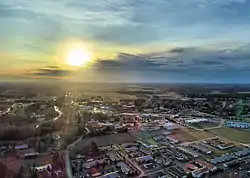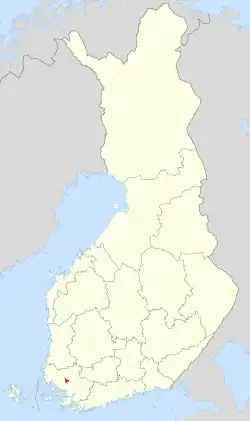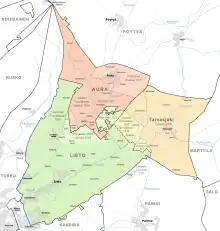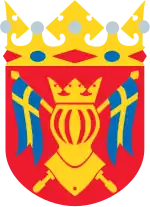Aura | |
|---|---|
Municipality | |
| Auran kunta Aura kommun | |
 | |
 Coat of arms | |
 Location of Aura in Finland | |
| Coordinates: 60°39′N 022°35′E / 60.650°N 22.583°E | |
| Country | |
| Region | Southwest Finland |
| Sub-region | Loimaa sub-region |
| Charter | 1917 |
| Government | |
| • Municipal manager | Jari Kesäniemi |
| Area (2018-01-01)[1] | |
| • Total | 95.58 km2 (36.90 sq mi) |
| • Land | 95.01 km2 (36.68 sq mi) |
| • Water | 0.59 km2 (0.23 sq mi) |
| • Rank | 301st largest in Finland |
| Population (2023-09-30)[2] | |
| • Total | 3,967 |
| • Rank | 195th largest in Finland |
| • Density | 41.75/km2 (108.1/sq mi) |
| Population by native language | |
| • Finnish | 96.8% (official) |
| • Swedish | 0.6% |
| • Others | 2.5% |
| Population by age | |
| • 0 to 14 | 19% |
| • 15 to 64 | 60.2% |
| • 65 or older | 20.8% |
| Time zone | UTC+02:00 (EET) |
| • Summer (DST) | UTC+03:00 (EEST) |
| Climate | Dfb |
| Website | www.aura.fi |
Aura (Finnish pronunciation: [ˈɑu̯rɑ]) is a municipality of Finland. The name derives from the river Aura and the plough (aura in Finnish) reminiscent shape of the municipality. The municipality was established in 1917 from parts of Lieto and Pöytyä.
It is part of the Varsinais-Suomi region. The municipality has a population of 3,967 (30 September 2023)[2] and covers an area of 95.58 square kilometres (36.90 sq mi) of which 0.59 km2 (0.23 sq mi) is water.[1] The population density is 41.75 inhabitants per square kilometre (108.1/sq mi).
The municipality is unilingually Finnish.
Geography
Villages
In 1967, Aura had 23 legally recognized villages (henkikirjakylät):[5]
- Auvainen
- Hypöinen
- Ihava
- Järvenoja
- Järykselä
- Kaerla
- Karviainen
- Kinnarla
- Kuuskoski
- Käetty
- Lahto
- Laukkaniitty
- Leikola
- Leinikkala
- Leppäkoski
- Paimala
- Pitkäniitty
- Prunkkala
- Puho
- Seppälä
- Sikilä
- Simola
- Viilaila
History

The area was initially a part of the Lieto parish. A church was built in the village of Prunkkala in 1636, forming a new chapel community. In 1908, an order to separate Prunkkala from Lieto was made. The villages of Kuuskoski, Hypöinen, Viilala and Lahto were transferred to it from Pöytyä. The parish became fully independent in 1917 under the current name Aura, after the Aura train station and the community that had formed around it in the late 19th century.[6][7]
Demographics
In 2020, 19.0% of the population of Aura was under the age of 15, 60.2% were aged 15 to 64, and 20.8% were over the age of 65. The average age was 42.0, under the national average of 43.4 and regional average of 44.0. Speakers of Finnish made up 96.8% of the population and speakers of Swedish made up 0.6%, while the share of speakers of foreign languages was 2.6%. Foreign nationals made up 2.1% of the total population.[8]
The chart below, describing the development of the total population of Aura from 1975-2020, encompasses the municipality's area as of 2021.
|
| ||||||||||||||||||||||||||||||||||||
| Source: Statistics Finland[9] | |||||||||||||||||||||||||||||||||||||
Urban areas
In 2019, out of the total population of 3,941, 2,705 people lived in urban areas and 1,166 in sparsely populated areas, while the coordinates of 70 people were unknown. This made Aura's degree of urbanization 69.9%.[10] The urban population in the municipality was divided between two urban areas as follows:[11]
| # | Urban area | Population |
|---|---|---|
| 1 | Aura railway station area | 2,700 |
| 2 | Lieto railway station area | 5[lower-alpha 1] |
Economy
In 2018, 5.2% of the workforce of Aura worked in primary production (agriculture, forestry and fishing), 34.9% in secondary production (e.g. manufacturing, construction and infrastructure), and 57.6% in services. In 2019, the unemployment rate was 5.7%, and the share of pensioners in the population was 23.7%.[12]
The ten largest employers in Aura in 2019 were as follows:[13]
- Municipality of Aura, 138 employees
- Reka Kumi Oy, 63 еmployees
- Turun Osuuskauppa, 55 employees
- Oy WW-Offshore Ab, 41 employees
- Aurajoki Oy, 40 employees
- Humana Hoiva Oy, 37 employees
- JPV-Engineering Oy, 31 employees
- Criminal Sanctions Agency, 30 employees
- Posti Oy, 28 employees
- Pilke päiväkodit Oy, 21 employees
See also
Notes
References
- 1 2 "Area of Finnish Municipalities 1.1.2018" (PDF). National Land Survey of Finland. Retrieved 30 January 2018.
- 1 2 "Preliminary population statistics 2023, September". StatFin. Statistics Finland. Retrieved 26 October 2023.
- ↑ "Demographic Structure by area as of 31 December 2022". Statistics Finland's PX-Web databases. Statistics Finland. Retrieved 6 September 2023.
- ↑ "Population according to age (1-year) and sex by area and the regional division of each statistical reference year, 2003–2020". StatFin. Statistics Finland. Retrieved 2 May 2021.
- ↑ Inki, Valto; Papunen, Pentti (1967). "Aura". Suomenmaa: maantieteellis-yhteiskunnallinen tieto- ja hakuteos. 1: Ahlainen–Hausjärvi. Helsinki: WSOY.
- ↑ "SuomalainenPaikannimikirja_e-kirja_kuvallinen.pdf" (PDF). kaino.kotus.fi (in Finnish). p. 30. Retrieved December 28, 2022.
- ↑ "Suomen Sukututkimusseura". hiski.genealogia.fi (in Finnish). Retrieved December 28, 2022.
- ↑ "Key figures on population by region, 1990-2020". StatFin. Statistics Finland. Archived from the original on 2019-04-06. Retrieved 1 May 2021.
- ↑ "Population according to age (1-year) and sex by area, 1972-2020". StatFin. Statistics Finland. Archived from the original on 2019-05-25. Retrieved 1 May 2021.
- ↑ "Degree of urbanisation by area, 2019". StatFin. Statistics Finland. Archived from the original on 2019-11-26. Retrieved 1 May 2021.
- 1 2 "Population in urban settlements and sparsely populated areas by age, sex and municipality, 2019". StatFin. Statistics Finland. Archived from the original on 2019-11-26. Retrieved 1 May 2021.
- ↑ "Municipal key figures 1987-2020 (with the 2021 regional division)". StatFin. Statistics Finland. Archived from the original on 2021-04-26. Retrieved 1 May 2021. (2018 and 2019)
- ↑ "Kunnittainen toimipaikkatilasto" (in Finnish). Statistics Finland. Archived from the original on 2016-11-14. Retrieved 1 May 2021.
External links
![]() Media related to Aura at Wikimedia Commons
Media related to Aura at Wikimedia Commons
- Municipality of Aura – Official website (in Finnish)
